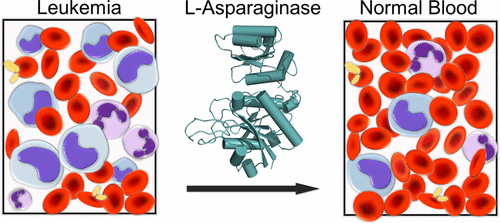当前位置:
X-MOL 学术
›
Biochemistry
›
论文详情
Our official English website, www.x-mol.net, welcomes your
feedback! (Note: you will need to create a separate account there.)
Improving the Treatment of Acute Lymphoblastic Leukemia.
Biochemistry ( IF 2.9 ) Pub Date : 2020-08-12 , DOI: 10.1021/acs.biochem.0c00354 Ashish Radadiya 1 , Wen Zhu 2 , Adriana Coricello 1, 3 , Stefano Alcaro 3, 4 , Nigel G J Richards 1, 5
Biochemistry ( IF 2.9 ) Pub Date : 2020-08-12 , DOI: 10.1021/acs.biochem.0c00354 Ashish Radadiya 1 , Wen Zhu 2 , Adriana Coricello 1, 3 , Stefano Alcaro 3, 4 , Nigel G J Richards 1, 5
Affiliation

|
l-Asparaginase (EC 3.5.1.1) was first used as a component of combination drug therapies to treat acute lymphoblastic leukemia (ALL), a cancer of the blood and bone marrow, almost 50 years ago. Administering this enzyme to reduce asparagine levels in the blood is a cornerstone of modern clinical protocols for ALL; indeed, this remains the only successful example of a therapy targeted against a specific metabolic weakness in any form of cancer. Three problems, however, constrain the clinical use of l-asparaginase. First, a type II bacterial variant of l-asparaginase is administered to patients, the majority of whom are children, which produces an immune response thereby limiting the time over which the enzyme can be tolerated. Second, l-asparaginase is subject to proteolytic degradation in the blood. Third, toxic side effects are observed, which may be correlated with the l-glutaminase activity of the enzyme. This Perspective will outline how asparagine depletion negatively impacts the growth of leukemic blasts, discuss the structure and mechanism of l-asparaginase, and briefly describe the clinical use of chemically modified forms of clinically useful l-asparaginases, such as Asparlas, which was recently given FDA approval for use in children (babies to young adults) as part of multidrug treatments for ALL. Finally, we review ongoing efforts to engineer l-asparaginase variants with improved therapeutic properties and briefly detail emerging, alternate strategies for the treatment of forms of ALL that are resistant to asparagine depletion.
中文翻译:

改善急性淋巴细胞白血病的治疗。
1-天冬酰胺酶(EC 3.5.1.1)最早在近50年前被用作联合药物疗法的组成部分,用于治疗急性淋巴细胞白血病(ALL),这是一种血液和骨髓癌。施用这种酶以降低血液中的天冬酰胺水平是现代ALL临床方案的基础。的确,这仍然是针对任何形式的癌症中特定代谢弱点的疗法的唯一成功实例。然而,三个问题限制了1-天冬酰胺酶的临床应用。首先,将1-天冬酰胺酶的II型细菌变体施用于患者,其中大多数是儿童,其产生免疫应答,从而限制了可耐受该酶的时间。第二,我-天冬酰胺酶在血液中经受蛋白水解降解。第三,观察到毒副作用,其可能与酶的1-谷氨酰胺酶活性有关。该观点将概述天冬酰胺耗竭如何对白血病母细胞的生长产生负面影响,讨论l-天冬酰胺酶的结构和机理,并简要描述化学修饰形式的临床上有用的l-天冬酰胺酶的化学用途,例如Asparlas,这是最近给予的FDA批准将其用于儿童(婴儿至年轻人)作为ALL多药治疗的一部分。最后,我们审查正在进行的努力,工程师升-天冬酰胺酶变体具有改善的治疗特性,并简要详细介绍了新兴的替代策略,用于治疗对天冬酰胺耗尽有抵抗力的ALL形式。
更新日期:2020-09-08
中文翻译:

改善急性淋巴细胞白血病的治疗。
1-天冬酰胺酶(EC 3.5.1.1)最早在近50年前被用作联合药物疗法的组成部分,用于治疗急性淋巴细胞白血病(ALL),这是一种血液和骨髓癌。施用这种酶以降低血液中的天冬酰胺水平是现代ALL临床方案的基础。的确,这仍然是针对任何形式的癌症中特定代谢弱点的疗法的唯一成功实例。然而,三个问题限制了1-天冬酰胺酶的临床应用。首先,将1-天冬酰胺酶的II型细菌变体施用于患者,其中大多数是儿童,其产生免疫应答,从而限制了可耐受该酶的时间。第二,我-天冬酰胺酶在血液中经受蛋白水解降解。第三,观察到毒副作用,其可能与酶的1-谷氨酰胺酶活性有关。该观点将概述天冬酰胺耗竭如何对白血病母细胞的生长产生负面影响,讨论l-天冬酰胺酶的结构和机理,并简要描述化学修饰形式的临床上有用的l-天冬酰胺酶的化学用途,例如Asparlas,这是最近给予的FDA批准将其用于儿童(婴儿至年轻人)作为ALL多药治疗的一部分。最后,我们审查正在进行的努力,工程师升-天冬酰胺酶变体具有改善的治疗特性,并简要详细介绍了新兴的替代策略,用于治疗对天冬酰胺耗尽有抵抗力的ALL形式。











































 京公网安备 11010802027423号
京公网安备 11010802027423号